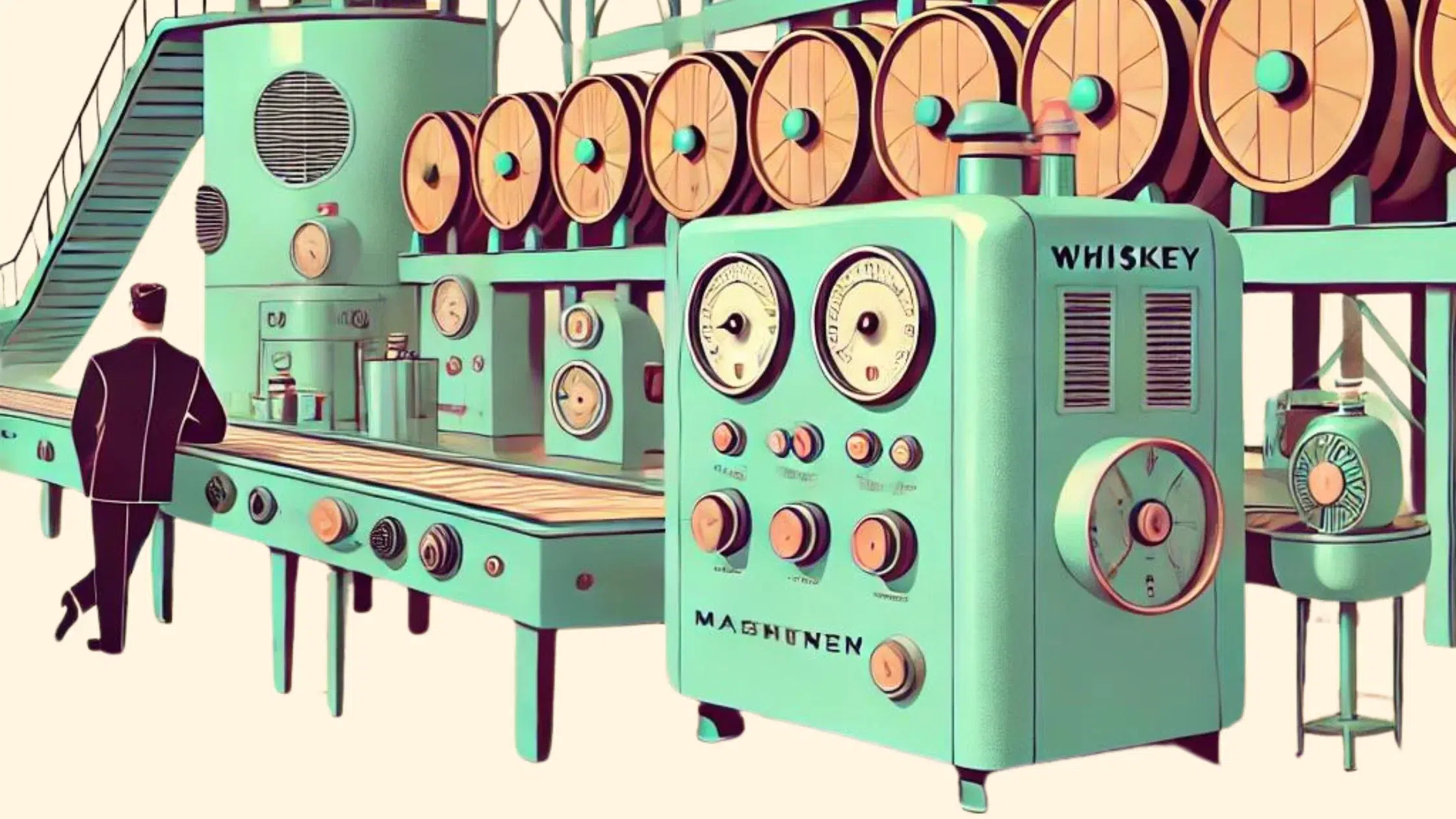Whiskey lovers, unite! Ever wondered what magic turns that clear spirit into the amber nectar full of complex flavors we adore? The secret lies in the whiskey aging process, a fascinating journey that transforms raw spirit into a masterpiece of taste.
It all starts with oak barrels, the unsung heroes that lend whiskey its unique flavors, colors, and aromas. From the subtle dance of chemicals to the influence of climate and the mysterious “angel’s share,” every step in the aging process adds layers of depth to the final product. Whether you’re a seasoned connoisseur or new to the whiskey world, understanding the art and science behind aging will deepen your appreciation for this beloved beverage.
So, grab a glass, and let’s dive into the world of whiskey aging, where time weaves its magic to create the rich, complex flavors that make whiskey a timeless treasure.
What is the whiskey aging process?
The whiskey aging process is a critical phase in whiskey production that significantly influences its flavor, aroma, and color. This process entails storing distilled whiskey in wooden barrels for a certain period. Oak is the preferred wood due to its ability to impart a range of flavors and characteristics to the whiskey, thanks to its unique chemical properties.
During aging, a dynamic interaction unfolds between the whiskey and the barrel. The oak barrel is more than a mere vessel; it is an active participant that adds flavors such as vanilla, caramel, and spices to the whiskey. This is largely dependent on the type of oak used and its pre-use treatment, like charring.
The aging period also sees the phenomenon of the “angel’s share,” where some alcohol evaporates, further concentrating the whiskey’s flavor. The climate in which the barrels are stored plays a significant role, with temperature variations causing the whiskey to expand and contract, thereby enhancing flavor infusion. The length of aging is crucial as well, with longer periods typically leading to a more complex flavor profile, though this varies based on the whiskey’s desired characteristics.
In essence, the whiskey aging process is a blend of art, science, and tradition, transforming the spirit through its interaction with wood into a beverage rich in history and flavor. This process is not merely about the passage of time but involves a complex interplay of factors that together define the unique identity of each whiskey.
Why is aging important for whiskey?
Aging is crucial in the whiskey-making process, serving as the transformative phase that turns a raw, fiery spirit into a complex and nuanced beverage. It significantly enhances flavor complexity, allowing the whiskey to imbibe a plethora of flavors from the oak barrels. These flavors range from vanilla and caramel to a variety of spices, contributing to the whiskey’s depth and richness.
Additionally, aging is essential for removing harsh flavors from the new spirit, smoothing its rough edges to yield a more refined drink. The interaction between the whiskey and the oak, along with the evaporation of alcohol—known as the “angel’s share”—mellows the whiskey, enhancing its smoothness and drinkability. In summary, the aging process is indispensable in the craft of whiskey production.
It not only enriches the spirit with complex flavors but also ensures a smoother, more palatable final product. This transformation is what whiskey enthusiasts cherish, making aging a pivotal step in the creation of high-quality whiskey.
Enhances flavor complexity
The aging process is pivotal in augmenting the whiskey’s flavor complexity. As the whiskey resides within oak barrels, it imbibes a rich tapestry of flavors from the wood, encompassing vanilla, caramel, and various spices. This interaction infuses the whiskey with a complexity and depth that is unachievable in its nascent, distilled state.
The myriad of flavors acquired during aging crafts a sophisticated and layered beverage, catering to a wide array of palates.
Removes harsh flavors
Aging is essential for softening the whiskey, eliminating the initial harshness characteristic of the newly distilled spirit. The phenomenon known as the “angel’s share” refers to the gradual evaporation of alcohol, which, together with the whiskey’s interaction with the oak, tempers its bite. This process ensures that the resulting whiskey is not only rich and complex in flavor but also smooth and enjoyable to consume, effectively removing any abrasive harshness that might compromise the whiskey’s overall appeal.
How does the aging process work?
The aging process of whiskey is a complex journey that transforms a clear, distilled spirit into a richly flavored beverage. This transformation begins when the whiskey is transferred into oak barrels, which are fundamental in imparting complex flavors to the spirit. The type of oak and its pre-use treatment, such as charring, significantly influence the flavor profile of the whiskey, adding notes of vanilla, caramel, and spices.
Throughout the aging period, the whiskey interacts chemically with the barrel. Environmental fluctuations, including variations in temperature and humidity, cause the whiskey to expand into and then contract out of the wood, facilitating a deeper infusion of flavors. This process is also characterized by the “angel’s share”, a term for the portion of whiskey that evaporates, which helps to concentrate the remaining liquid’s flavor.
The location of the warehouse and the climate it is situated in further impact the aging process, influencing both the rate at which the whiskey ages and the character of the final product. Ultimately, the aging process is a delicate interplay between time, wood, and environment, each factor crucial in crafting the whiskey’s final taste and aroma.
Types of barrels used
The selection of barrels is pivotal in the whiskey aging process, with oak barrels standing out as the preferred choice due to their ability to enrich the whiskey with a complex flavor profile. The specific type of oak and the treatments it undergoes, such as charring, are crucial in shaping the whiskey’s ultimate flavor.
- American Oak Barrels: Impart sweet and robust vanilla flavors, often used for bourbon and new-make Scotch.
- European Oak Barrels: Known for adding spicy and dark fruit flavors, commonly used in sherry cask aging.
- Ex-Bourbon Barrels: Offer subtle vanilla and caramel notes, widely used in Scotch whisky production.
- Ex-Sherry Barrels: Contribute rich fruit and nutty flavors, favored for maturing premium whiskies.
Oak barrels
Oak barrels are valued in whiskey production for their durability and the unique chemical makeup they possess, which is key to developing a broad spectrum of flavors. These barrels contribute various notes ranging from vanilla and caramel to toasty and woody nuances, making them essential to the aging process.
Charred barrels
Charred barrels are created by lightly burning the inside of the oak barrel, which induces a charred layer. This charring triggers chemical reactions that unlock flavors and assist in purifying the whiskey, removing undesirable compounds and infusing the spirit with a complex, smoky flavor.
The role of the environment
The environment in which whiskey is aged plays a significant role, with environmental factors such as temperature and humidity directly influencing the aging speed and flavor evolution. These conditions determine the whiskey’s interaction with the barrel, ultimately affecting the spirit’s final character.
- Kentucky’s Climate: Hot summers and cold winters enhance the aging of bourbon, leading to a faster maturation process.
- Scottish Highlands: Cooler temperatures and consistent humidity levels allow for a slower, more gradual maturation, developing subtle flavors.
Warehouse location
The location of the aging warehouse can profoundly affect the whiskey aging process. Factors like altitude, proximity to bodies of water, and the general climate conditions of the area contribute to the whiskey’s unique flavor profiles, with each location offering distinct characteristics.
- Coastal Warehouses: Can impart a saline or maritime quality to the whiskey, often found in Scotch whiskies.
- Inland Warehouses: Tend to produce whiskey with more pronounced wood influence due to less humidity and more stable temperatures.
- High Altitude Warehouses: The lower oxygen levels and pressure can slow the aging process, potentially leading to smoother whiskies.
Climate variations
Climate variations play a critical role in how whiskey matures within the barrels. Areas with significant temperature fluctuations promote a more dynamic interaction between the whiskey and the wood, potentially hastening the aging process and enriching the flavor profile. In contrast, regions with stable climates tend to yield a slower, more nuanced aging process, allowing for the gradual development of subtle flavors.
- Tropical Climates: Such as those in India or Taiwan, can accelerate aging, requiring less time to achieve depth of flavor.
- Temperate Climates: Found in regions like Scotland or Ireland, offer a slow and steady maturation, developing complexity over many years.
What factors influence the aging process?
Several key factors significantly impact the whiskey aging process, each shaping the spirit’s ultimate flavor and character. Temperature, Humidity, and Barrel interaction are crucial elements, with each playing a pivotal role in defining the whiskey’s flavor profile. These elements collectively orchestrate the aging process, determining the quality and distinctiveness of the final whiskey.
Temperature
Temperature is a key driver in the whiskey aging process, directly influencing how quickly the whiskey matures.
| Region | Average Temperature Range | Impact on Aging |
|---|---|---|
| Scotland | 45°F – 60°F (7°C – 15°C) | Slower aging process, allowing for gradual flavor development. |
| India | 50°F – 104°F (10°C – 40°C) | Accelerated aging due to higher temperatures, leading to a faster maturation and more intense interaction with the barrel. |
High temperatures accelerate aging
High temperatures foster a more active environment within the barrel, speeding up the aging process by enhancing the whiskey’s interaction with the wood, leading to a quicker development of the flavor profile.
Humidity
Humidity plays a crucial role in the aging process, impacting the evolution of the whiskey’s character over time.
| Region | Average Humidity | Impact on Aging |
|---|---|---|
| Scotland | 70% – 90% | Higher humidity leads to slower alcohol evaporation, preserving whiskey’s volume but potentially altering flavor concentration. |
| Taiwan | 60% – 80% | High humidity with warmer temperatures accelerates aging and increases the “angel’s share,” concentrating flavors more rapidly. |
High humidity affects evaporation rates
High humidity leads to a higher rate of water evaporation compared to alcohol, altering the concentration of flavors and shaping the overall character of the whiskey.
Barrel interaction
The interaction between the whiskey and the barrel is central to the aging process, significantly affecting the whiskey’s final flavor and aroma.
| Factor | Impact on Flavor |
|---|---|
| Wood’s chemical composition | Oak barrels release compounds like vanillin and lignin, which impart vanilla and toasty flavors. |
| Barrel size and shape | Smaller barrels increase the surface area in contact with the whiskey, accelerating flavor development. |
Wood’s chemical composition
The chemical composition of the wood from which the barrel is made imparts a variety of flavors to the whiskey, such as vanilla, caramel, and toasty notes, crucial for the spirit’s complexity.
Barrel size and shape
The size and shape of the barrel influence the aging process, with smaller barrels increasing the surface area in contact with the whiskey, potentially speeding up flavor development. The shape can also affect the rate of evaporation and how the flavors are distributed within the barrel.
How is the age of whiskey determined?
The age of whiskey is determined by the time it spends aging in the barrel, from the moment it is barreled until it is bottled. This aging period is essential for the whiskey to acquire its distinctive flavors, colors, and character from the wood. Once bottled, the aging process ceases, and the age indicated on the bottle represents the duration of barrel aging.
A key factor in this process is the “angel’s share”, which is the portion of whiskey that evaporates during aging. This natural evaporation is integral to the concentration of flavors in the whiskey that remains. Thus, the age of whiskey is a reflection of its maturity and the complexity it has developed through its tenure in the barrel.
Time in the barrel
The duration of barrel aging is critical to whiskey’s flavor development. This phase allows the whiskey to absorb distinctive flavors from the wood and undergo essential chemical changes, enhancing its complexity and character. The longer the whiskey matures in the barrel, the deeper and more nuanced its flavor profile becomes.
Different countries or regions have varying legal definitions of what constitutes the “age” of whiskey, impacting the labeling and marketing of the final product.
Impact of “angel’s share”
The “angel’s share” is the term given to the whiskey that evaporates during the aging process. This natural reduction in volume is pivotal in concentrating the remaining whiskey’s flavors and aromas, significantly enriching its quality. The rate of evaporation, and thus the impact of the “angel’s share,” varies with the storage environment, playing a key role in defining the whiskey’s final character.
| Climate | Average Annual “Angel’s Share” Loss |
|---|---|
| Scotland (cool, damp) | 1-2% |
| Kentucky (variable, with hot summers) | 4-5% |
| Taiwan (hot, humid) | 8-12% |
What are the effects of aging on whiskey’s flavor?
Aging profoundly transforms whiskey’s flavor, turning a potent spirit into a beverage celebrated for its richness and complexity. Through the aging process, whiskey develops a spectrum of flavors, including vanilla, caramel, and toasty notes, which are imparted by the wood of the barrel. These flavors emerge from the chemical interactions between the whiskey and the oak, with the duration of aging significantly influencing the intensity and depth of these flavors.
Moreover, aging is crucial for mellowing down the harsh, fiery notes of the spirit, resulting in a smoother and more enjoyable drink. The “angel’s share”, or the portion of whiskey that evaporates during aging, concentrates the flavors, enhancing the whiskey’s complexity. The choice of barrel, whether new or previously used for aging other spirits, along with the environmental conditions such as temperature and humidity, further shapes the whiskey’s final flavor profile.
Through this intricate process, whiskey acquires its distinctive character, celebrated for its depth and nuanced complexity.
Influence of the barrel type
The type of barrel used for aging markedly impacts the whiskey’s flavor profile. Different woods and their previous contents (like sherry, bourbon, or wine barrels) can introduce a range of flavors, from spicy to sweet, influencing the overall taste.
| Barrel Type | Previous Contents | Flavors Imparted |
|---|---|---|
| American Oak | New (Charred) | Vanilla, Coconut, Toasted Wood |
| European Oak | Sherry | Dark Fruits, Nuttiness, Spice |
| Ex-Bourbon | Bourbon | Sweet Corn, Vanilla, Caramel |
| Ex-Sherry | Sherry | Raisin, Fig, Nutty, Spicy |
American oak vs. European oak
Choosing between American oak and European oak barrels affects the flavor nuances in whiskey. American oak tends to impart sweeter notes, such as vanilla and coconut, due to its tighter grain and unique chemical makeup. Conversely, European oak offers spicier, more robust flavors, contributing to the whiskey’s depth and complexity.
| Oak Type | Chemical Compounds | Flavors Imparted |
|---|---|---|
| American Oak | High Lactones | Vanilla, Coconut, Sweet Notes |
| European Oak | Low Lactones, High Tannins | Spicy, Robust, Dark Fruit Notes |
This detailed comparison highlights the significant influence that the type of barrel and its previous contents have on the aging process and the resulting flavor profile of whiskey.
How do different regions approach whiskey aging?
Different regions have unique approaches to whiskey aging, shaped by local traditions, climate conditions, and legal requirements. In Scotland, the production of Scotch whisky adheres to strict regulations, including a minimum aging requirement of three years in oak barrels, which is essential for developing its characteristic depth and complexity. Irish whiskey is noted for its smoothness, a quality often attributed to the diverse types of barrels used for aging, such as those previously holding bourbon or sherry, which introduce distinctive flavors to the spirit.
In America, the impact of climate on the aging process is pronounced, with temperature variations across states influencing the maturation rate and flavor profile of American whiskey. Each region’s specific approach to whiskey aging contributes to the creation of unique flavor profiles and styles, showcasing the global diversity of whiskey.
| Region | Climate Conditions | Barrel Types | Legal Requirements | Notable Flavors |
|---|---|---|---|---|
| Scotch (Scotland) | Varies by region; generally cool and wet | Predominantly American oak; some use of European oak and ex-sherry barrels | Minimum 3 years in oak barrels | Peaty and smoky in Islay; fruity and floral in Speyside |
| Irish | Mild and moist | Variety including American oak, ex-bourbon, and ex-sherry barrels | Minimum 3 years | Smooth and often fruity |
| American | Varies widely; from hot and humid in Kentucky to cooler in the Pacific Northwest | New, charred oak barrels for bourbon; varied for other types | Minimum 2 years for straight whiskey; specific rules for bourbon and Tennessee whiskey | Sweet and vanilla notes in bourbon; smooth and charcoal-filtered in Tennessee whiskey |
Scotch
Scotch whisky, particularly from regions like Islay and Speyside, showcases how local climate can influence aging. Islay whiskies are known for their peaty and smoky flavors, a result of the damp, maritime climate that influences the peat used in malting as well as the aging process. Speyside whiskies, on the other hand, are often fruity and floral, benefiting from the region’s milder climate and the use of sherry casks for aging.
Irish
Irish whiskey has seen a resurgence in pot still whiskey, characterized by its smooth and often fruity flavor profile. The use of diverse barrel types, including those previously holding bourbon or sherry, plays a significant role in this smoothness and complexity. The historical and emerging trends in barrel usage highlight Ireland’s innovative approach to whiskey aging.
American
The legal requirements for aging American whiskey, particularly bourbon and Tennessee whiskey, underscore the diversity within the category. Bourbon must be aged in new, charred oak barrels, contributing to its sweet vanilla and caramel notes. Tennessee whiskey, while similar to bourbon in many respects, must also be filtered through charcoal before aging, known as the Lincoln County Process, which imparts a distinctive smoothness.
The varying climates across the United States, from the hot summers in Kentucky to the cooler, more temperate climate in the Pacific Northwest, further influence the aging process and the final flavor profile of American whiskey.
What are the legal requirements for aging whiskey?
Legal requirements for aging whiskey vary significantly across different regions, reflecting the unique traditions, climate conditions, and quality standards of each whiskey-producing nation. These regulations are crucial in shaping the character and quality of the whiskey produced in these regions, ensuring that consumers enjoy spirits that meet high standards of excellence.
In the United States
The United States has specific legal requirements for aging whiskey, with distinctions made between different types of whiskey such as bourbon, rye, and others. For example, straight whiskey in the U.S. must be aged for a minimum of two years in new, charred oak barrels.
This requirement is part of what gives American whiskey its distinctive character.
| Type of American Whiskey | Minimum Aging Requirement | Barrel Requirement |
|---|---|---|
| Straight Bourbon | 2 years | New, charred oak barrels |
| Straight Rye | 2 years | New, charred oak barrels |
| Tennessee Whiskey | 2 years | New, charred oak barrels |
| Corn Whiskey | No minimum | Uncharred or used oak barrels |
In Scotland
Scotland, known for its Scotch whisky, mandates a minimum aging period of three years in oak barrels for all types of Scotch whisky. The type of Scotch (e.g., single malt, blended) does not change the minimum aging requirement but can influence the type of barrels used and the blending process.
| Type of Scotch Whisky | Minimum Aging Requirement | Barrel Requirement |
|---|---|---|
| Single Malt Scotch | 3 years | Oak barrels |
| Blended Scotch | 3 years | Oak barrels |
| Single Grain Scotch | 3 years | Oak barrels |
| Blended Malt Scotch | 3 years | Oak barrels |
In Ireland
Irish whiskey must also be aged for a minimum of three years, but the country’s distillers often use a variety of barrel types to achieve a wide range of flavor profiles. Ireland’s geographic and climatic conditions, such as its mild, moist climate, play a significant role in the aging process, influencing the character of the whiskey.
| Type of Irish Whiskey | Minimum Aging Requirement | Barrel Requirement |
|---|---|---|
| Single Malt Irish Whiskey | 3 years | Oak barrels |
| Grain Irish Whiskey | 3 years | Oak barrels |
| Pot Still Irish Whiskey | 3 years | Oak barrels |
| Blended Irish Whiskey | 3 years | Oak barrels |
How does the aging process end?
The aging process of whiskey concludes when it has achieved its desired flavor profile, a critical decision made by the master distiller or a designated tasting team. This determination is based on the whiskey’s age and its sensory development within the barrel. Upon reaching maturity, the whiskey is removed from the barrel and readied for bottling, signifying the cessation of the aging process.
At this juncture, the whiskey may either be bottled directly to capture its developed character or might undergo additional filtration or blending, depending on the distillery’s specific practices and the product’s target profile. This meticulous decision-making process ensures that the whiskey meets the distillery’s quality and flavor standards, satisfying the expectations of discerning consumers.
Decision by the master distiller
The decision to end the aging process is a nuanced art, primarily falling to the master distiller. This expert conducts regular tastings, assessing the whiskey’s development through sensory evaluation techniques such as nosing and tasting. Factors like aroma, flavor complexity, and balance are scrutinized.
For example, a master distiller at a renowned Scottish distillery might decide that a particular batch of single malt has reached its peak flavor after 12 years, based on its smoothness and the depth of its vanilla and oak notes.
Bottling considerations
Once the aging process is deemed complete, bottling considerations come into play. The whiskey might be chill-filtered to remove fatty acids and proteins that could cloud the whiskey when cold, ensuring a clear appearance. Alternatively, some whiskeys are bottled at cask strength, offering a more robust flavor profile by preserving the whiskey’s original alcohol content.
Each of these decisions—whether to filter, blend, or adjust the proof—impacts the final taste and character of the whiskey, tailoring it to the desired consumer experience.
What happens to whiskey after aging?
After the aging process concludes, whiskey embarks on the final stages of its journey to consumers. Bottling is the primary step, where the whiskey is transferred from its barrels into bottles. This stage may involve filtration to eliminate impurities and, in some cases, dilution to adjust the alcohol content to the desired proof.
The bottling process can be detailed into several steps, including filtration, where the whiskey may be filtered to remove any remaining particulate matter; dilution, where water may be added to bring the whiskey to its desired proof for bottling; and quality control, where the whiskey is tested to ensure it meets the distillery’s standards. Certain whiskeys may also experience further maturation in different barrels, a technique used to infuse additional flavors or refine its profile further. Once bottled, the whiskey’s flavor profile remains largely unchanged, as the dynamic interaction with wood, a key component of the aging process, is halted.
The whiskey is then packaged and distributed, ready for enjoyment by whiskey lovers worldwide. It’s important to note that while the whiskey does not mature further once bottled, the conditions under which it is stored can affect its preservation. Avoiding direct sunlight and maintaining a consistent temperature can help preserve the whiskey’s flavor and quality over time.
This transition from barrel to bottle is essential, ensuring the whiskey retains the unique qualities and flavors cultivated during its aging.





